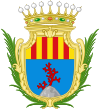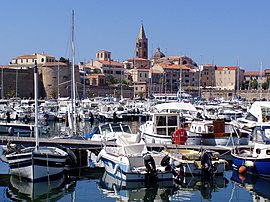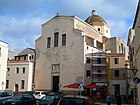Alghero
| Alghero / L'Alguer | ||
|---|---|---|

|
|
|
| Country | Italy | |
| region | Sardinia | |
| province | Sassari (SS) | |
| Local name | S'Alighera / L'Alguer ( approx ) | |
| Coordinates | 40 ° 33 ′ N , 8 ° 19 ′ E | |
| height | 7 m slm | |
| surface | 224.43 km² | |
| Residents | 43,743 (Dec. 31, 2019) | |
| Population density | 195 inhabitants / km² | |
| Factions | Fertilia, Maristella, Il Carmine, La Pivarada, Porto Conte, Santa Maria La Palma, Sant'Agostino | |
| Post Code | 07041 | |
| prefix | 079 | |
| ISTAT number | 090003 | |
| Popular name | Algheresi | |
| Patron saint | San Michele Arcangelo | |
| Website | Alghero | |
 View of the old town of Alghero |
||
Alghero , Catalan L'Alguer ([ ləlˈɣe ] (standard) or [ ləlˈɣeɾ ] (local)), Sardinian S'Alighera , is a city in the province of Sassari on the Italian island of Sardinia . From a linguistic point of view, it is important as a Catalan language island .
Location and dates
Alghero has 43,743 inhabitants (as of December 31, 2019) on an area of 225 km² and is located on the north west coast of Sardinia.
The old town has many medieval architectural monuments that are typical of medieval cities in the area of the Crown of Aragon . Thick walls enclose the old town, which lies on a rocky promontory. Narrow alleys and stone steps lead to the squares and churches.
history
The period of foreign rule over Sardinia, which began around 800 BC. Beginning with the Phoenicians and Carthaginians in the 4th century BC and continuing through several intermediate stages, the 11th century in Alghero continued with the fact that the Genoese Doria family freed the city in the name of the Republic of Genoa from Saracen pirates , occupied it and turned it into a fortress against the competing Pisan rebuilt. In 1354 the Catalans (the House of Aragon ) conquered the city, expanded the fortress and expelled the local population. This led, among other things, to the establishment of the city of Villanova Monteleone .
language
Part of the population still speaks Catalan as colonists from Barcelona repopulated the city after the Sardinians were expelled in 1372 after a popular uprising against the Aragonese king Pero IV .
Catalan was replaced as the official language by Spanish in the 17th century, and later by Italian. In 1990 about 60% of the population still understood the Catalan dialect of Alghero, which is related to the idiom of Valencia ( Valencian ) and is currently only passed on to their children by a few families. Various associations promote the language and culture, such as B. the Maria Montessori Center and the cultural work of Alghero .
Despite different guidelines for the protection of minorities in the Italian constitution, the language is poorly protected on site. The inhabitants also speak Italian and understand at least the local Sardinian dialects.
The residents of Alghero call their city Little Barcelona (Barceloneta) .
Attractions
The Cathedral of Santa Maria of the Roman Catholic Diocese of Alghero-Bosa dates from the 16th century, but has been rebuilt several times. It did not get its classical facade until the 19th century. The Chiesa di San Michele (Church of Saint Michael) served as a cathedral until it was built. It was rebuilt in the 17th century; the previous building of the old church came from the 14./16. Century. This church is still the seat of the Jesuit college today. It is shaped like a cross. The dome of the church dates from 1950 and is one of the most eye-catching focal points in the entire city: it is covered with glazed, colored roof tiles.
From the port there are regular boats to the Grotta di Nettuno , a stalactite cave accessible from the sea . Another attraction, the Domus de Janas of Anghelu Ruju , are located about 10 km north of Alghero. Between Fertilia and Maristella, about 10 km northwest of Alghero, there is the Palmavera nuragic complex .
Festivals and traditions
Among the living traditions in Alghero, the song of the Sibyl stands out, which, like in Mallorca , is sung on Christmas night.
Holy Week
The week before Easter is marked by ritual celebrations in Alghero, which culminate in the Good Friday procession, the Processione del Discendimento . In its frame, the wooden figure of Christ from the cathedral is removed from the cross and carried together with banners and other statues in a coffin through the city to the Chiesa della Misericordia.
traffic
Alghero has a system of city ( servizi urbani ) and regional buses ( servizi extraurbani ), which connect both the individual districts of Alghero with each other and the city with places in the near and far . The bus service is operated by the company Trasporti Regionali della Sardegna (ARST).
There is a train connection to Sassari from the train station just outside the city center , which is regularly served by FdS (Ferrovia della Sardegna) trains. The route began at the port until 1988.
Alghero has an international airport ( IATA code : AHO ). Year-round scheduled flight connections connect Alghero with Rome and Milan , since February 2004 there has been a regular flight connection to the Catalan city of Girona . The low-cost airline Ryanair connects Alghero with the German airports of Bremen , Dortmund , Hahn (Hunsrück) , Memmingen and Niederrhein as well as with Bratislava in Slovakia, Graz in Austria and other cities in Europe.
Town twinning
sons and daughters of the town
- Antonello Cuccureddu (* 1949), football player and coach
- Dario Del Fabro (* 1995), football player
- Enzo Favata (* 1956), jazz musician
literature
- Manuel Pagès i Mercader : Crònica descriptiva d'Alguer , 1957 (Catalan)
Web links
- L'Alguer: a Catalan language island in Sardinia. Archived from the original on October 25, 2008 ; accessed on March 9, 2018 .
- Alghero (German)
Individual evidence
- ↑ Statistiche demografiche ISTAT. Monthly population statistics of the Istituto Nazionale di Statistica , as of December 31 of 2019.
- ↑ Andrea Behrmann: Su Desclavament - the long Good Friday night in Alghero. (No longer available online.) Sardinien.com, April 16, 2009, archived from the original on April 20, 2014 ; accessed on May 30, 2014 .
- ↑ a b c Alghero - La Porta del Mediterraneo - Città candidata Capitale Italiana della Cultura 2018 - Dossier seconda fase. Retrieved June 7, 2017 .











